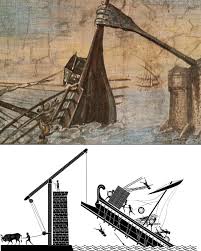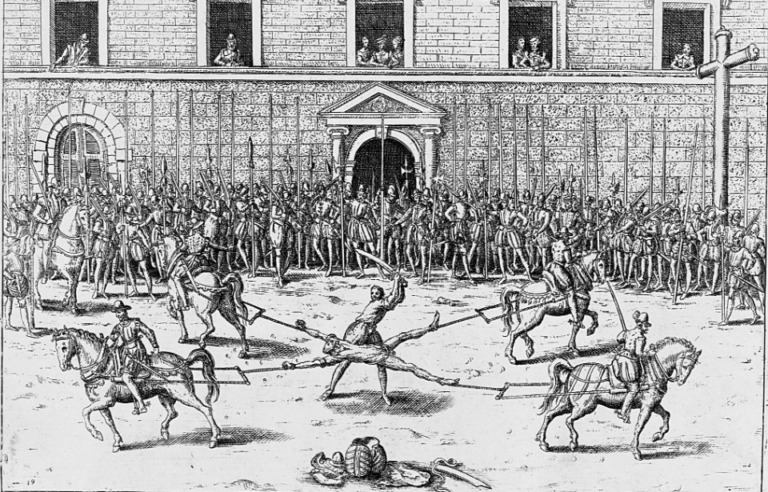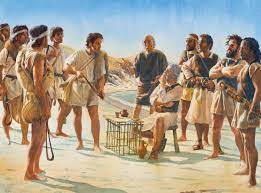Unraveling the Myth: Did Archimedes’ Iron Claw Really Crush Roman Ships?
Discover the truth behind the legendary Iron Claw of Archimedes. Did this ancient weapon really devastate a Roman fleet during the Siege of Syracuse?
The Iron Claw of Archimedes
Archimedes of Syracuse is renowned not only for his mathematical genius but also for his inventive prowess. Among his many inventions, the Iron Claw stands out as one of the most intriguing and enigmatic. The Iron Claw, often depicted in historical accounts as a formidable defensive weapon, is believed to have been used during the Roman siege of Syracuse in 212-211 BCE.
Description and Mechanism
The Iron Claw was a purportedly enormous mechanical device designed to lift and capsize enemy ships. According to ancient sources, the device resembled a giant claw or crane, made of iron and mounted on a sturdy platform. This platform was presumably positioned on the city’s walls, allowing the Iron Claw to be lowered onto attacking Roman vessels.
Key features of the Iron Claw:
- Construction: Made of iron with a claw-like structure.
- Function: Designed to lift and overturn Roman ships.
- Operation: Likely operated using pulleys and counterweights.
The exact mechanism of the Iron Claw remains a topic of debate among historians and engineers. Some theories suggest that the device used a series of pulleys and ropes to create the necessary lifting force. Others propose that it might have involved a counterweight system to enhance its effectiveness.
Historical Accounts of the Iron Claw
Ancient historians such as Polybius and Plutarch provide the primary sources of information about the Iron Claw. These accounts describe the device in dramatic terms, emphasizing its role in repelling Roman attacks. Polybius, for instance, wrote about the inventive genius of Archimedes and the significant impact of his defensive machines.
“Archimedes, using his intellect and mechanical ingenuity, constructed devices that were not only ingenious but also effectively thwarted the Roman attempts to capture Syracuse.” — Polybius
However, there is a lack of concrete archaeological evidence to corroborate these descriptions. The historical accounts, while vivid, may be embellished, leading to the mythic status of the Iron Claw.
The Roman Fleet and Its Siege of Syracuse
The siege of Syracuse was a crucial episode in the Second Punic War. The Roman fleet, commanded by General Marcus Claudius Marcellus, sought to capture the strategically important city of Syracuse. The siege lasted for about two years and was marked by fierce resistance from the Syracusans, who were aided by Archimedes’ technological innovations.
Overview of the Roman Fleet
The Roman fleet consisted of numerous ships, including quinqueremes and triremes. These ships were heavily armed and designed for both combat and transport. The Romans employed various siege tactics, including the use of battering rams and siege towers, to breach the city walls.
The Siege of Syracuse
During the siege, Archimedes’ defensive mechanisms played a pivotal role. His inventions, including the Iron Claw, were intended to protect the city from naval assaults. Despite the Roman’s superior numbers, the Syracusans managed to hold off the attackers for a significant period.
The siege eventually concluded with the fall of Syracuse, but Archimedes’ devices, including the Iron Claw, are remembered for their impressive technological innovation.
Impact and Effectiveness of the Iron Claw
The effectiveness of the Iron Claw has been a subject of historical and engineering debate. While ancient accounts suggest that it played a crucial role in the defense of Syracuse, modern analyses question the practical implementation and success of such a device.
Evidence Supporting Its Use
Historical texts provide descriptions of the Iron Claw’s use against Roman ships. Polybius and Plutarch both highlight its effectiveness in repelling attacks, but their accounts are not always consistent with the technical feasibility of such a device. Archaeological findings from the siege, such as remnants of war machinery, provide partial support for the existence of Archimedes’ inventions but do not confirm the precise function of the Iron Claw.
Criticisms and Doubts
Many historians and engineers argue that the Iron Claw, as described in ancient texts, may not have been as effective as reported. The logistical challenges of constructing and operating such a large mechanical device on the city walls raise questions about its practicality. Additionally, some scholars suggest that the device could have been more symbolic than functional, serving as a deterrent rather than a decisive weapon.
Historical Myths and Misconceptions
The legend of the Iron Claw is shrouded in myth and exaggeration. The dramatic accounts of Archimedes’ inventions have contributed to a mythic portrayal of the device, which may not align with historical reality.
Legend vs. Reality
The portrayal of the Iron Claw in historical texts often blends fact with fiction. Ancient historians, eager to highlight the ingenuity of Archimedes, may have embellished the accounts to emphasize the device’s impact. The lack of corroborating evidence makes it difficult to separate historical facts from legends.
Impact on Roman Naval Strategies
Regardless of its actual effectiveness, the legend of the Iron Claw influenced Roman naval strategies and perceptions of Greek ingenuity. The stories of Archimedes’ inventions contributed to the broader narrative of Greek technological prowess and its impact on Roman military tactics.
Summary of Findings
The Iron Claw of Archimedes remains one of history’s most fascinating mechanical devices. While historical accounts provide vivid descriptions of its design and use, the actual impact of the Iron Claw on the Roman fleet is uncertain. The device symbolizes the remarkable ingenuity of Archimedes but also serves as a reminder of the challenges in distinguishing historical fact from myth.
Biography of Archimedes
| Name | Archimedes of Syracuse |
|---|---|
| Born | 287 BCE |
| Died | 212 BCE |
| Occupation | Mathematician, Engineer, Physicist |
| Notable Works | Principle of Buoyancy, Archimedean Screw, Claw of Archimedes |
References
- Polybius on Archimedes https://en.wikipedia.org/wiki/Polybius
- Plutarch’s Account https://en.wikipedia.org/wiki/Plutarch
- History of the Iron Claw https://www.historydefined.net/iron-claw-of-archimedes/






